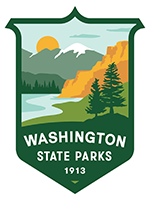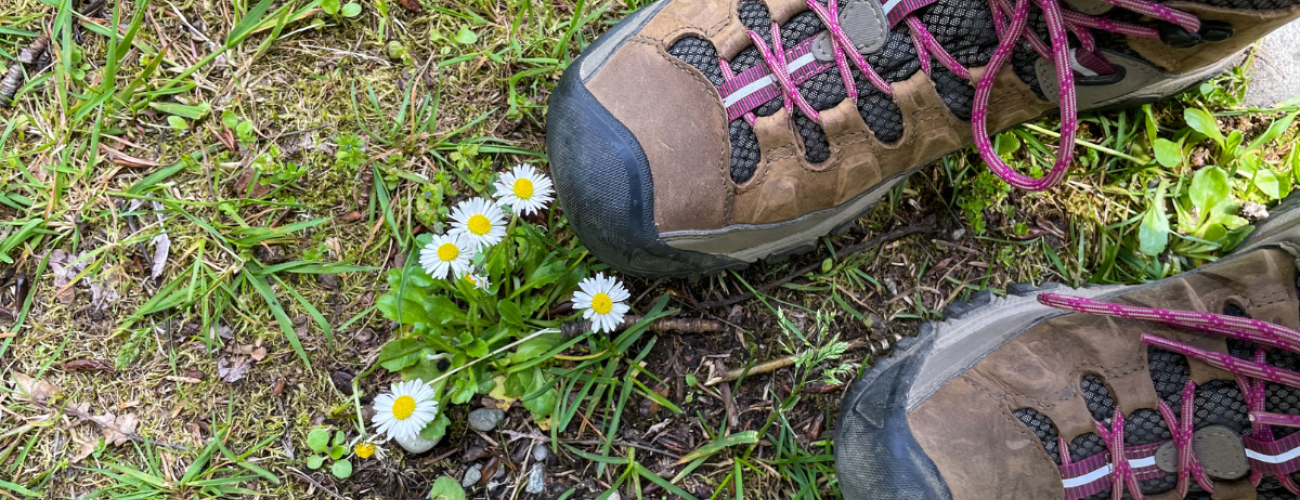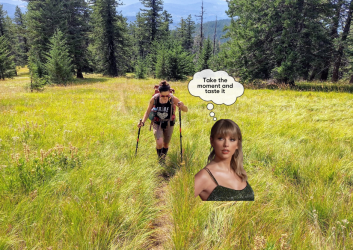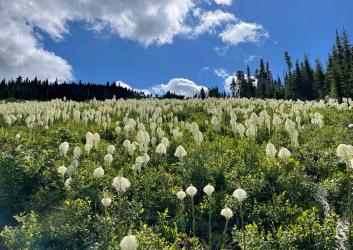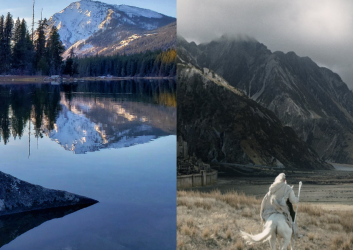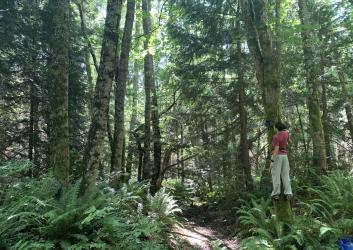Where to splurge vs. skimp on gear
Image caption: Person stands in boots at the Ollalie State Park grassy picnic area before beginning a hike.
Outdoor gear can be an expensive barrier for many people trying to get outside.
Our staff is here to help you figure out what to add to your gear closet and to offer their thoughts on gear “must haves” vs. “nice to haves,” including hacks, modifications and items to skip. (We all love a creative duct tape hack and Patagonia duuuuuuuuupe.)
Our state parks welcome people of all backgrounds. We hope this blog will alleviate a few cost constraints, which many folks list as a barrier to the outdoors.
Of course, gear choices are often quite personal. It may be the technology, the feel, the color, the fit or just something we can’t explain. Either way, here are our staff’s top picks for outdoor gear and whether it’s worth it to break the bank, or find a cheaper alternative.
SKIMP - camp chairs
Basic camp chairs are fine for most campers. They cost $10 to $20 and they’re easy to pack around. Most of our campsites have picnic tables, but something a little bit softer will make the whole camping experience better.
A few of our staff consider this item a splurge though.
“Zero gravity camp chairs may be bulky to pack, but heaven at the end of a long day relaxing by the campfire,” says Marketing & Sales Manager Stephanie McDermott.
These babies cost anywhere from $40 to $150, so you’ll have to decide if the “ahhh” factor is worth the price.
SPLURGE – footwear
Whether you’re camping, hiking, running after kiddos or enjoying endless lake days, you may be on your feet for hours at a time.
The average person takes 2,000 steps to travel one mile – and then factor in the terrain of hiking trails. With every step, footwear (not just your shoes, socks too) plays a critical role in keeping your feet happy and blister-free.
“I would invest in a shoe that is comfortable and good in different terrains and weather,” said Administrative Assistant, Cassandra Alarcon. “Who likes wet socks?”
It may sound weird, but wool socks make a difference in all seasons (yes, even summer). They help protect your feet during those high-intensity activities. They also don't rub as much when wet or sweaty, and they control temperature a bit better than synthetic socks.
Splurging on high-quality footwear allows you to be comfy and safe on uneven terrain. In the long run, it may save you money, as good shoes take longer to wear out.
Emily Masseth and her dog Scout love going camping at state parks in their small tent.
SKIMP - tents
Figuring out what tent is right for you can be an in-tents experience. There are so many brands, styles and sizes – many of which can be expensive. The good news is, once you buy one, they usually last quite a long time.
Take into consideration the size you need to fit yourself or your whole family. It’s sometimes nice to have a larger tent, which you can use to store things, or as a mobile changing room.
Depending on what kind of camping you’ll be doing year after year, you may not need something fancy. If you plan to hit a state park in the spring and summer season, we suggest going with a cheaper, smaller tent (which is also much easier to pack around). Although most smaller tents won’t be as cool as your neighbor’s penthouse tent, they get the job done.
“I have a smaller 2-person tent that is super easy to set up by myself,” said Communications Consultant, Emily Masseth. “But sometimes I don’t even bother bringing a tent. I usually like car camping better. There is less set up and take down and it’s a bit cozier – especially when I bring my dog.”
Other staff made the argument for splurging on their home away from home:
“A few years ago, I purchased an easy pop-up, blackout tent. I was very hesitant because it’s fairly expensive, but it’s the best decision I’ve made,” said Parks Creative Services Programs Specialist, Holly Sproul. “It has two rooms and doors on both sides, one is even a swinging door. This tent has been a lifesaver for my family with how easy it is to put up. We no longer have to connect poles or fight the tension rods. The tent goes up in less than 10 minutes with two people helping. The blackout feature doesn’t get pitch black, but we no longer wake up with the sun at 5 a.m. The tent also stays cool during the day so if a nap is calling, you aren’t sweating like crazy.”
SPLURGE - backpack
“A well-fitted backpacking pack is worth every penny. When your pack is well balanced you can comfortably hike farther,” said Property & Acquisition Specialist, Tanya Moore.
If your backpack doesn’t fit properly, it can cause shoulder, back and hip pain on and after the trail. Depending on how far you’re going, any ol’ backpack may do. But, if you’re planning to trek several miles or take up backpacking, we suggest you head to your nearest outfitter and get a pack that fits you properly. You’ll thank us later!
SKIMP – clothing
“My advice is to wear comfortable, flexible pants, whether they are hiking pants or yoga pants,” said Interpretive Specialist Kelsey Lang. “If you are new to hiking and fear bugs, spiders, or harmful plants, pants will make you feel more protected.”
Any shirt is fine in summertime, but as we all know, the weather in Washington can be unpredictable. Avoid cotton when there is rain in the forecast. Cotton absorbs moisture quickly and is slow to dry out. Unlike wool and silk, cotton conducts heat away from your body, making it hard to stay warm during our colder months. Spring for something wool or synthetic, like a dry-fit shirt.
“I am obsessed with sun hoodies,” says Natural Resource Specialist Stella Waxwing. “They keep you cool on hot days and protect you from the sun. When paired with long pants and a wide-brimmed hat (another must have), I only need to use a little sunscreen for my face and hands.”
SKIMP - hiking poles
Most hiking poles are similar, especially for beginners. They can assist you in going uphill or downhill on uneven terrain. If you’re new to hiking or even snowshoeing, try finding a place near you that rents hiking poles. They are usually inexpensive, and the rental allows you to try before you buy.
“I prefer poles that fold or are adjustable,” said Communications Consultant, Emily Masseth “The fixed poles, or the poles that come as is and are not adjustable, are harder to pack around. When I am hiking or snowshoeing, I want to have the option to either use them or put them away in my backpack. I have been on many snowshoe hikes with fixed polls that I rented before buying my adjustable ones, wishing I had not brought them or had a way to put them away.”
Many outdoor outfitter stores rent out a variety of gear. If you’re on the fence about buying something, or you don’t want to pay an arm and a leg for that top-of-the-line tent, renting is a good way to go! And when you do plan to buy something expensive, check to see if there is a warranty. Some gear has a lifetime warranty, and the company may repair and replace broken parts or the whole item.
The bottom line is, everyone will have advice and opinions when it comes to outdoor gear. Choosing the clothing and tools that make you feel safe and relaxed is what’s most important.
In our next blog, you will find information about what to expect when visiting a state park for the first time, along with a packing list for day adventures and overnight camping trips. Stay tuned!
SPLURGE – down or synthetic jacket
With Washington’s crazy weather, you’ll want something versatile that keeps you dry in the rain and warm in the snow.
“A good synthetic or sustainably harvested down puffy will help regulate your body temperature,” says Communications Consultant, Meryl Lassen. “I'm not overly hot in my puffy in the low lands, but I can go snowshoeing for hours and not freeze.”
She adds that, “in western Washington you might go with cheaper synthetic fill - and splurge on rain jacket and pants. In eastern and central Washington, I want a toasty down puffy.”
Photo at right: Meryl Lassen swears by her cozy puffy jacket, a big splurge, which is equally effective on a fall evening at Fort Columbia as it is on the slopes of Mount Rainier.
For more on outdoor gear, the Washington Trails Association has put together a full library of gear-specific blogs to help you decide what works best for you and your upcoming adventures.
Originally published August 25, 2023
